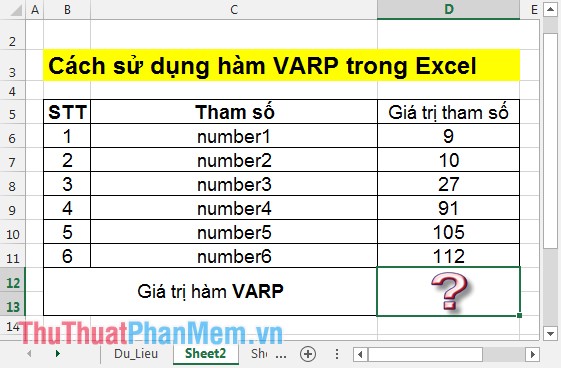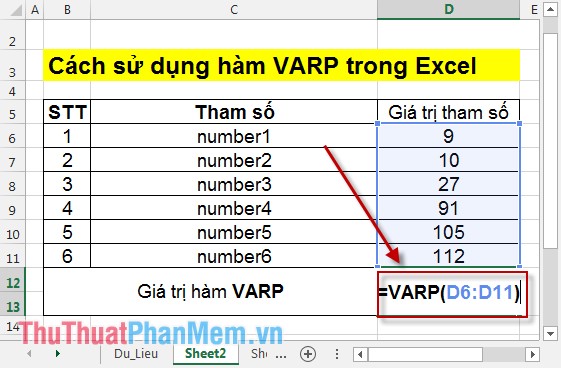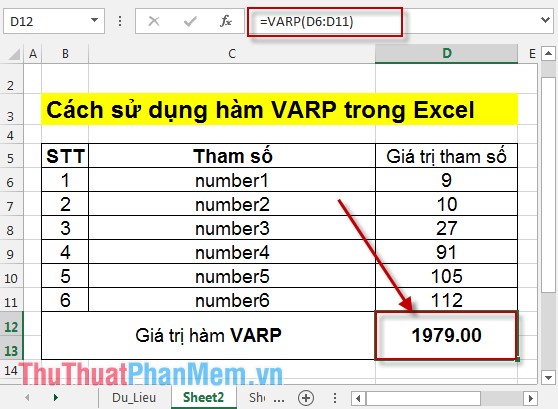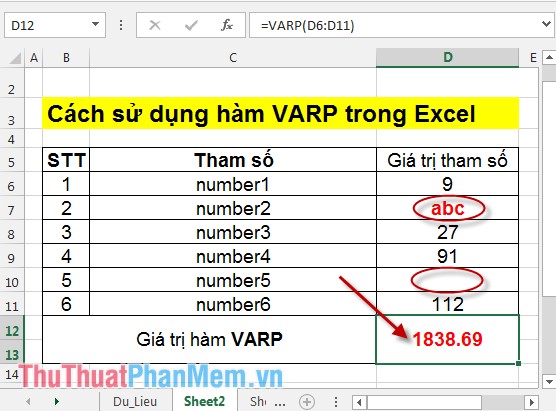VARP function - Functions for calculating variance based on an entire population in Excel
The following article details how to use the VARP function, the function of calculating variance on an entire set.
Description: The function calculates the variance over the entire set, the arguments of the function can only be arrays or references, where the logical values and numerical representations when typing directly are counted.
Syntax : VARP (number1, [number2], .) .
Inside:
- Number1 : The first numeric argument corresponding to a set, is a required parameter.
- Number2, . : Are numerical arguments from 2 -> 255 corresponding to a set, as optional parameters.
Attention:
- Because the VARP function assumes its arguments are an entire population, the case of a data sample representing a set needs to use the VAR function to calculate variance.
- Function arguments can be numbers, names, arrays, or references that contain numbers.
- Where arguments are arrays or references of new values or references are counted while logical values, text, and blank values are ignored.
- Arguments that are text or error values that return an error value because they cannot be converted to numeric types.
- If you want to use logical values and present numeric text into a reference to calculate need to use additional VARPA function .
- Equation of the VARP function :

Inside:
- x is the sample mean AVERAGE (number 1, number 2, .) .
- n is the sample size.
For example:
Calculate the value of the VARP function to find the variance for the durability of tools with the following number values:

Step 1 : In the cell to calculate enter the formula: = VARP (D6: D11) .

Step 2: Press Enter -> VARP function value is:

If the arguments are not numeric or are blank -> these values are ignored:

Above is how to use the VARP function and some notes when using the function.
Good luck!
You should read it
- VAR.S function - Function that calculates variance based on a sample, ignoring logical values and text in Excel
- VAR function - The function of estimating variance based on a sample in Excel
- STDEVPA function - The function of estimating standard deviations based on an entire population including both text and logical values in Excel
- STDEV.P function - The function returns the standard deviation based on the whole in Excel
- VARA - Function that calculates variance based on a sample, including logical values and text in Excel
- How to fix the SUM function doesn't add up in Excel
- GUSSE function - The function returns the probability that an element of the population is normalized in Excel
- MS Excel 2007 - Lesson 6: Calculation in Excel
May be interested
- MS Excel 2007 - Lesson 6: Calculation in Excel
 excel supports many calculation functions, logic functions for calculating, filtering, collating and analyzing data. this is also a feature that makes excel an indispensable tool for office jobs. in this article, tipsmake.com will show you how to use the overview calculation function in excel 2007.
excel supports many calculation functions, logic functions for calculating, filtering, collating and analyzing data. this is also a feature that makes excel an indispensable tool for office jobs. in this article, tipsmake.com will show you how to use the overview calculation function in excel 2007. - How to use the MOD function and QUOTIENT function in Excel
 injury in excel has many ways of doing it, can be used manually or using the calculation function.
injury in excel has many ways of doing it, can be used manually or using the calculation function. - The SUM function (sums) in Excel
 sum in excel is essential in calculating and processing your data, so the sum and sumif functions are used a lot by you. but for those of you who are new to excel spreadsheets, you probably don't fully understand these two functions.
sum in excel is essential in calculating and processing your data, so the sum and sumif functions are used a lot by you. but for those of you who are new to excel spreadsheets, you probably don't fully understand these two functions. - CONFIDENCE.T function - The function returns the confidence interval of the population by using the Student's t-distribution in Excel
 confidence.t function: the function returns the confidence interval of the population by using the student's t-distribution. support functions from excel 2010 onwards. syntax: confidence.norm (alpha, standard_dev, size)
confidence.t function: the function returns the confidence interval of the population by using the student's t-distribution. support functions from excel 2010 onwards. syntax: confidence.norm (alpha, standard_dev, size) - Calculation of age in Excel
 to calculate age in excel, we can use these two functions as year or datedif functions.
to calculate age in excel, we can use these two functions as year or datedif functions. - How to use the SUBTOTAL function in Excel
 the subtotal function in excel is used in many different cases, helping you to sum subtotals in a list or database, unlike the sum function in excel such as counting cells, calculating average, finding the largest / smallest value. or sum the filtered list values in excel
the subtotal function in excel is used in many different cases, helping you to sum subtotals in a list or database, unlike the sum function in excel such as counting cells, calculating average, finding the largest / smallest value. or sum the filtered list values in excel - Basic Excel functions that anyone must know
 the basic functions in excel such as the excel function, the excel statistics function we summarized below will be very helpful for you who often have to work on excel spreadsheets, especially in the field of accounting. let's refer to offline.
the basic functions in excel such as the excel function, the excel statistics function we summarized below will be very helpful for you who often have to work on excel spreadsheets, especially in the field of accounting. let's refer to offline. - CONFIDENCE.NORM function - The function returns the confidence interval of the population by using a normalized distribution in Excel
 confidence.norm function: the function returns the confidence interval of the population by using normalized distributions. support functions from excel 2010 onwards. syntax: confidence.norm (alpha, standard_dev, size)
confidence.norm function: the function returns the confidence interval of the population by using normalized distributions. support functions from excel 2010 onwards. syntax: confidence.norm (alpha, standard_dev, size) - How to use the IFS function in Excel 2016
 the ifs function in excel is a logical function introduced in excel 2016. this function is a function that replaces the nested if function and is much easier to use. the ifs function checks one or more conditions and returns a value that meets the first true condition.
the ifs function in excel is a logical function introduced in excel 2016. this function is a function that replaces the nested if function and is much easier to use. the ifs function checks one or more conditions and returns a value that meets the first true condition. - How to use Excel's VALUE function
 excel's value function will convert a string to a digital form, which can be combined with other functions such as left function, right function, mid function.
excel's value function will convert a string to a digital form, which can be combined with other functions such as left function, right function, mid function.










 PERCENTILE function - The function returns the kth percentile in Excel
PERCENTILE function - The function returns the kth percentile in Excel PERCENTRANK function - The function returns the rank of the value in Excel
PERCENTRANK function - The function returns the rank of the value in Excel POISSON function - The function returns the Poisson distribution in Excel
POISSON function - The function returns the Poisson distribution in Excel STDEV function - The function of estimating standard deviations based on a sample in Excel
STDEV function - The function of estimating standard deviations based on a sample in Excel AMORDEGRC function - The function returns the depreciation for each accounting period in Excel
AMORDEGRC function - The function returns the depreciation for each accounting period in Excel STDEVP function - The function of calculating standard deviations in Excel
STDEVP function - The function of calculating standard deviations in Excel